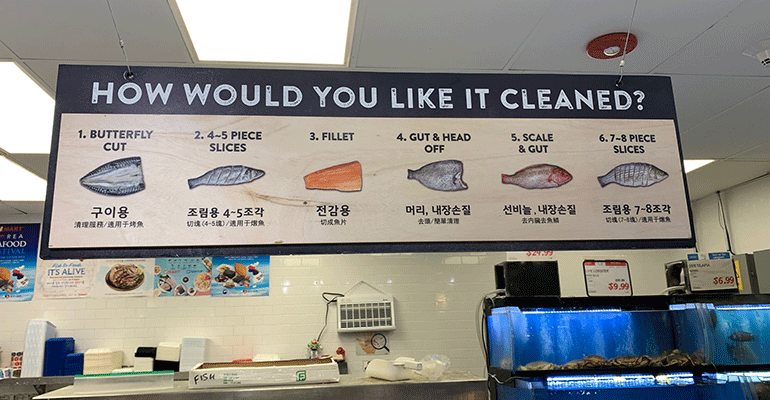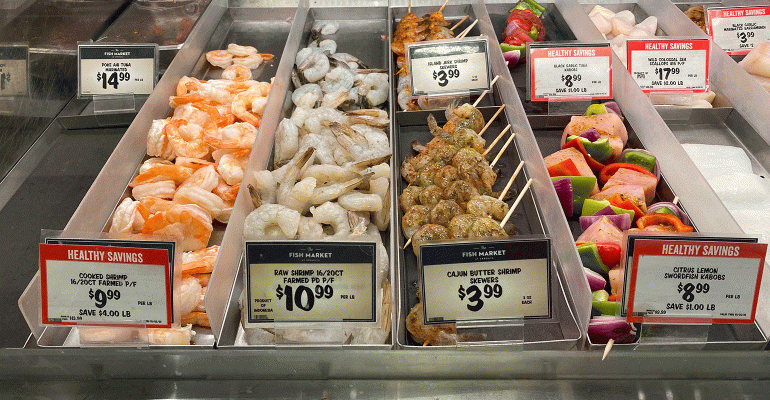The battle for share of stomach by supermarket seafood department operators and restaurants is heating up.
With more foodservice operators that closed locations or cut back on menu items during the pandemic enhancing operations, supermarkets are facing the steeper challenge of remaining attractive to the large base of shoppers who switched to at-home dining the pandemic but are susceptible to meal-preparation fatigue and a desire for convenience.
On the positive side, seafood department activity is unlikely to revert to lower pre-pandemic levels as many consumers who over the last three years have more comfortable preparing seafood at home are likely to maintain that interest, analysts said. Yet, it still is vital for retailers to enhance the seafood shopping experience if they are to keep restaurants from infringing on their turf, said Maeve Webster, president of Menu Matters, an Arlington, Va.-based food industry consulting firm. “The more supermarkets can lean into the idea that they aren't just a source of products for purchase but can be the venue that also offers knowledge, the better that they can create an ownable market position,” she said.
Retailers, for instance, can educate customers on the distinct attributes of varied species, Webster said, such as product flavor, texture, and preparation techniques. In addition, it is crucial that seafood departments have associates with the necessary skills to instruct customers, she said.

Retailers can make the seafood department more alluring by offering additional services.
“There should be a counter where consumers can ask questions and feel they are speaking with someone who not only knows what they are talking about but is specifically there to help them in a frictionless process,” Webster said. “Training and hiring are key, as well as making sure the staff knows that their role is as much to provide hospitality as it is to dole out product.”
Indeed, seafood operators should continually seek ways to add value to the department, analysts said. “Restaurants will rebound a bit and eating out will be more affordable as prices come down,” said Rick Stein, vice president of fresh foods for the Arlington, Va.-based food industry association FMI. “But food eaten at home is going to stay at record levels. Seafood can win in that play, but it will take a lot of work by the retailer to educate and advise consumers and help them make the good choices.”
Such measures can include emphasizing the health benefits of eating seafood multiple times a week while also continuing to offer preparation advice via such vehicles as recipe cards and videos, Stein said. In addition, operators can better appeal to price-conscious shoppers by merchandising portion sizes and using messaging that spotlights the per-portion, rather than just the per-pound, price, he said.
“A seafood department customer may see Chilean sea bass at $27.99 a pound and say, ‘I can’t afford it,’” Stein said. “But because they may only eat four ounces in a meal, it can end up costing about twenty-eight dollars to serve four persons at home instead of paying fifty-five dollars a plate at a fine-dining restaurant. Eating at home is a much more digestible concept.”
Restaurants, however, have the potential advantage of providing alluring information on menus to a captive audience that has the time to study the messages, Stein said. “A supermarket challenge is educating consumers when they are shopping, and that is not easy to accomplish,” he said. “That adds to the importance of having a robust training program for seafood department associates which gets them up to speed on the latest and greatest information they can use when talking with customers.”
Offering a wider range of attractive seafood species also is crucial for enticing shoppers to cook at home rather than dining out, Stein said. In addition to the “big three” of salmon, crab and shrimp, which generate more than two-thirds of department sales, retailers should consider providing such alternatives as cod, haddock, tilapia, trout, swordfish and tuna, and perhaps mussels, clams and oysters, he said.
“The frequent shopper is looking for different options, and retailers must have the selections that make the statement that they are in the seafood business,” he said. “That is important when trying to fight with restaurants.”
Yet, because many restaurants still are struggling with labor, cost and supply issues, seafood departments that create the perception of offering a more predictable eating experience can trigger further activity, Webster said. Merchandising value-added items, including selections that are pre-seasoned, pre-marinated, ready to cook or just require heating, as well as meal kits, can simplify shoppers’ meal preparation and position supermarkets to better match the convenience of eating out, she said.





